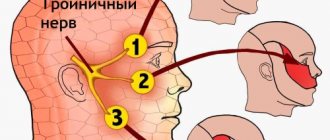Features of the disease
The vestibular apparatus is located in the temporal bone and is represented by the labyrinth of the inner ear. It contains otoliths that respond to the movement of endolymph. It changes its position when tilting and turning the head and mixes the otoliths. It is these cells that transmit a nerve impulse to the brain about a change in the position of the head. As a result, the part responsible for balance returns a signal to the muscle tissue, which keeps it in good shape or relaxes.
Structure of the middle ear
The main task of the vestibular apparatus is to provide balance and stability. But under the influence of various factors, some disturbances in its operation may occur. Most often, this leads to the appearance of vestibular neuritis. In some cases, it has an infectious nature. Manifests itself with regular dizziness, nausea and vomiting. Often there is damage to the upper branch, and in exceptional cases pathology of the lower branch is observed.
Vestibular neuritis, the symptoms of which are varied, occurs regardless of the age and gender of the person. It is usually installed in patients between 30 and 60 years of age.
Symptoms
The symptoms and treatment of vestibular neuritis are interrelated.
The main symptom of the disease is attacks of systemic dizziness, supplemented by vomiting, imbalance and nausea. These clinical manifestations are much more pronounced during head movement and when changing position. Other symptoms of neuritis are the following:
- Reducing dizziness while fixating the gaze on a specific object.
- The occurrence of spontaneous nystagmus, when involuntary eye movement is noted.
- Feeling of objects constantly rotating.
- The presence of fear of death along with the patient’s panic.
- Complete absence of any hearing impairment.
That is, with these symptoms, treatment can already begin.
Signs of vestibular neuritis and their duration can vary from a couple of hours to a week. And nystagmus can partially persist for up to three weeks. Even after nausea and dizziness stop, a person may feel extremely unsteady for several days, and in some patients, unsteadiness in gait can persist for a very long time, up to three years.
But it is worth noting that due to the high compensatory abilities of the vestibular apparatus, patients do not experience sensations that would interfere too much with their quality of life. Very rarely, this disease can recur, and during the second episode the vestibular nerve, which was initially healthy, is affected.
The most common causes of vestibular neuritis
The main reasons for the development of the disease have not been established. Based on many years of studying pathology, scientists have been able to identify a number of factors that influence and significantly increase the risk of dysfunction of the vestibular apparatus. These include:
- Colds.
- Overdose of certain drugs.
- Fungal, viral and infectious diseases.
- Pathologies of the cardiovascular system.
- Inner ear injuries.
- Meniere's disease.
Cold
Vestibular neuritis usually occurs as a result of infectious infection.
The pathology is accompanied by an increase in body temperature. In this case, the disease is an indirect sign.
Clinical picture
The main symptom of inflammation of the vestibular nerve is dizziness, accompanied by nausea and vomiting. It appears when trying to stand up or while turning the head. May last from several hours to several days. Signs of the disease also include:
- Reducing the intensity of dizziness when fixing the gaze.
- Trembling of limbs.
- Increased body temperature.
- Severe headaches of various types.
- Muscle tissue spasms.
- Numbness or paralysis of muscles.
- Deterioration of sensitivity or its complete absence.
- Feeling of “goosebumps” appearing all over the body.
Vestibular neuritis is not accompanied by a decrease in the quality of hearing in an isolated form. Signs of the disease appear abruptly, but after two or three days the condition begins to improve. But the inflammation continues to spread.
Types of vestibular neuritis
The classification of deviation is carried out according to the course of the pathological process.
Acute form
It is forming rapidly. It takes hardly more than a day for the clinical picture to fully develop. In this case, the severity of symptoms is maximum. The patient experiences strong manifestations from the entire extrapyramidal system: dizziness, nausea and other manifestations. Symptoms may spontaneously subside, and periods of imaginary well-being arise when a false sense of recovery arises. Without treatment, the disorder quickly progresses and becomes chronic. Critical, life-threatening complications are possible.
Treatment should begin within the first few days from the onset of changes. It is highly desirable in a specialized hospital setting for the patient to be under constant supervision. Acute vestibular neuritis is accompanied by a pronounced clinical picture.
Chronic form
Occurs much more often. It is characterized by a gradual increase in clinical symptoms and sluggish clinical signs compared to the acute form. Therapy is carried out in a hospital setting, as in the previous case. But there is more time for recovery. However, complications can arise at any stage; you should not relax. The chronic form can occur immediately, bypassing the acute one. Such forms of manifestation are most common.
Classification can also be carried out according to severity. However, there are no generally accepted methods for such a division; it depends on the criteria developed by national associations.
Diagnostics
Caloric test
In this case, first of all, a consultation with a neurologist is required. When contacting a specialist, the patient will need to accurately describe all the symptoms of the disease. The doctor conducts an examination and studies the medical history to identify the presence of possible factors causing the disease and disorders of the vestibular system.
Certain tests are also prescribed to assess the condition:
- Romberg test. The essence of the test is to determine the presence of the disease and the degree of impairment. To do this, the patient must stand up straight with his feet in line. Your arms should be straight forward. If there is pathology, the posture will be unstable.
- Caloric test. If the vestibular apparatus is inflamed during the patient's rotation around its own axis, a lack of reflexes will be noted on the affected side.
To confirm the diagnosis, CT and MRI are prescribed, as well as the caloric test method. In this case, liquid of different temperatures is placed into the ear canal. The condition is assessed by the reaction of the vestibular apparatus.
3.Symptoms
Vestibular neuronitis manifests itself acutely and occurs in paroxysms, usually in the form of a single episode, occasionally with distant relapses. In most cases, an attack of acute peripheral vestibulopathy resolves spontaneously within a few days, leaving residual symptoms that also gradually subside over a few weeks. It is known, however, that in elderly and senile people the period of convalescence (full recovery) often drags on for months.
Classic symptoms are intense, unbearable dizziness; nausea, vomiting; balance and coordination disorders. A neurological examination reveals nystagmoid movements of the eyeballs and ataxia in the Romberg position.
Diagnosis of vestibular neuronitis is quite complex; it requires a doctor to be highly qualified and have extensive clinical experience, since the same clinical manifestations are inherent in many other diseases. One of the most important differential diagnostic criteria is, in particular, the absence of hearing impairment. Differential diagnosis may also require additional studies (IMEP, MRI, etc.).
About our clinic Chistye Prudy metro station Medintercom page!
Treatment methods
If vestibular neuritis is diagnosed, treatment in severe cases takes place in an inpatient setting. The patient is prescribed special medications to reduce symptoms. As his condition improves, specially designed exercises are recommended to train the system.
To relieve symptoms, systemic glucocorticoid drugs are prescribed. The most effective are Prednisolone, Methylprednisolone and Hydrocortisone. A course of taking the following groups of drugs is also indicated:
- Vestibular suppressants and anti-nausea agents. Often, the doctor prescribes Dimenhydrinate or Metoclopramide. Tranquilizers and phenothiazines are prescribed intravenously for 3-5 days.
- Antiviral. In cases where vestibular neuritis occurs against the background of an infectious disease. This could be Acyclovir, Interferon and others.
- Means for improving microcirculation in the vestibular apparatus. This group includes Betaserk and Vestibo.
- Antihypoxants. They are designed to support the functioning of the nervous system. The most popular drugs with great effectiveness are Vinpocetine, Triducard and Trimetazidine.
Also, in order to cure vestibular neuritis, it is recommended to carry out specially designed gymnastics. It contains various head turns, tilts, and eye movements. During the first sessions, the patient may experience discomfort. The exercises are first performed lying down, then sitting and standing.
Treatment at home should be carried out as additional therapy. It is recommended to inhale essential oils of rosemary, lavender or camphor. They have a calming effect. You can also consume seaweed in powder form. It is taken one teaspoon per day. A course of therapy helps to relieve signs of the disease in a short time.
Treatment
Drug therapy
Treatment of the disease is only symptomatic, and the main goal of conservative therapy is to relieve vestibular dysfunction. The main group of medications in this case are vestibular suppressants: Promazine, Fluorphenazine, Thioridazine, Dimenhydrinate, Metoclopramide and the antiemetic - Scopolamine. A severe course of the disease requires a course of taking glucocorticosteroids Prednisolone or Hydrocortisone.
The progressing virus in the body must be suppressed with Cycloferon, Interferon or Acyclovir, and Betahistine helps accelerate vestibular compensation.
In addition to the complex, sedative tranquilizers are indicated: Sibazon, Gidazepam, Diazepam or Relanium.
Diet
In some cases, during the treatment process it will be useful to adjust your diet. Make sure your menu includes foods with the maximum phosphorus content. This group includes: fish, garlic, broccoli, legumes, oatmeal and wheat, as well as dairy products.
Vestibular gymnastics
It is recommended at the stage when the patient stops vomiting. As a rule, this is 4-5 days from the onset of the disease. Complexes are developed on the basis of habituation (development of addiction) of the brain in relation to abnormal stimuli with the goal of completely ignoring them in the future.
Gymnastics includes balance exercises, vestibular-ocular coordination exercises and vestibular-trunk exercises for coordination. There are several warnings and recommendations that must be followed.
- Gymnastics is prohibited during periods of colds or infectious diseases.
- Gymnastics is strictly contraindicated for patients with breathing difficulties and cardiovascular pathologies.
- All exercises should be performed at a slow pace. You can gradually increase the speed only as your body gets used to it.
- It is most advisable to perform gymnastics at least 2 times a day. The specific time in this case is not important.
- The total duration of the course should not be less than 1 month.
Example of vestibular-ocular exercises
- The patient looks up and down 20 times, gradually increasing the pace.
- Holding his head motionless, the patient looks from left to right 20 times.
- The gaze is focused on the finger of an outstretched hand at a distance of 30 cm from the tip of the nose. The finger approaches the nose and then moves away. The task is executed 20 times.
Example of vestibular-trunk
- The patient, with his eyes open, stands with his back to the corner part of the wall and gradually transfers his weight to his toes.
- The patient stands with his eyes closed and his back to the corner for 1 minute.
- The task is performed with an assistant. Throwing the ball back over the assistant's head. After this, the assistant throws the ball to the patient, moving around him clockwise and back.
Useful video
Check out the video examples of exercises:
Treatment at home
Among the treatment options for vestibular neuritis in traditional medicine, there are also several methods. It is worth considering that neurological diseases can cause serious complications if you do not seek qualified help in a timely manner. Likewise, all kinds of manipulations are dangerous, along with taking traditional medications, but without the official approval of your attending physician.
Traditional methods of treatment most often include tea with mint and ginger, alcohol tinctures from clover flowers, alcohol tinctures with propolis and honey, as well as inhalation of camphor and rosemary essential oils.
Attention! None of the listed methods can relieve inflammation of the vestibular nerve. All remedies have only a slight sedative effect.
What can't you do?
Fatty foods
To prevent the development of complications, every patient should know what is strictly forbidden to do if vestibular neuritis is diagnosed. If you are sick you cannot:
- Allow any loads. The patient is placed on bed rest.
- Eat fatty, sweet or fried foods.
- Not following a daily routine, going to bed late. The patient needs full sleep.
- Exercise immediately after symptoms disappear.
It is also not recommended to play sports games such as badminton or volleyball for two months.
Prevention measures
Scientists have not established the reasons for the development of vestibulopathy. That is why there are no special preventive measures to prevent the occurrence of a disorder. Patients are advised to promptly treat infectious diseases and follow the dosage of medications prescribed by the attending physician.
Vestibular neuritis is a disease characterized by dysfunction of the nerve endings of the inner ear. Treatment consists of taking several groups of medications and performing special exercises. The pathology manifests itself with many symptoms, but does not have special preventive measures. This is due to the fact that to date the true causes of the violation have not been identified. If the first signs occur, you should consult a doctor.
The article was prepared with the support of medical – https://mcvnimanie.ru
Medications
Courses of using systemic glucocorticosteroids in the form of Prednisolone, Hydrocortisone and Methylprednisolone help relieve painful symptoms. Let's name other medications that a doctor may recommend to get rid of the symptoms of vestibular neuritis.
- The use of vestibular suppressants and anti-nausea medications in the form of Dimenhydrinate and Metoclopramide. Many medications are prescribed intravenously for up to five days.
- The use of antiviral drugs in the form of Acyclovir, Cycloferon, Interferon.
- Drugs aimed at improving the microcirculation of the labyrinth, for example, Betaserc along with Betagistin and Vestibo.
- The use of antihypoxants - drugs to support the nervous system. For example, in this case, Trimectal is used along with Vinpocetine, Deprenorm, Triducard and Trimetazidine.
To speed up the restoration of healthy labyrinthine activity after relief of an acute clinical manifestation, vestibular gymnastics should be performed. In this case, movements of the eyes and head are performed, and, in addition, exercises for the torso. At first, a person may experience discomfort during gymnastics, but nevertheless it should be continued. All exercises are performed first in a lying position, then sitting, and then standing and walking.
Treatment of symptoms of vestibular neuritis with folk remedies is very effective.











